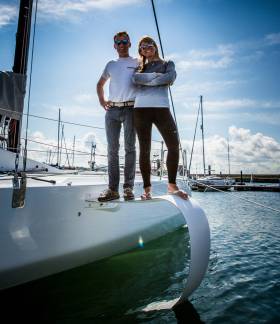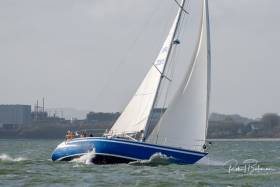Displaying items by tag: Dun Laoghaire Dingle Race
Former Afloat Irish Sailor of the Year, Conor Fogerty arrived onto the dock in Dun Laoghaire from Les Sables de Olinges with “Raw”, a fresh out of the box, foiling Beneteau Figaro 3, Ireland’s first IRC foiling Figaro keelboat.
Afloat previously reported on Fogerty's trip with Irish Beneteau agents BJ Marine to take a first look at the foiler last October here.
Howth Yacht Club-based Fogerty, along with co-skipper Susan Glenny, is competing in the Dun Volvo Dun Laoghaire to Dingle Race, starting on Wednesday the 12th of June. Glenny who grew up in the UK, is returning to her Irish roots as her mother’s side are from Kilkerley County Louth. Both have extensive offshore sailing CV’s including several transatlantic races and on some occasions competing against one another.
"The pair are looking at this venture as an intent to commit to becoming Ireland’s reps for the mixed two-person offshore keelboat event for the 2024 Olympics"
This is Raw’s first competitive race and it has been a very busy 36 hours for the team. Fogerty and Glenny are looking at this venture as an intent to commit to becoming Ireland’s representation for the mixed two-person offshore keelboat event for the 2024 Olympic Sailing in Paris.
This will be the first time mixed offshore racing will feature in the Olympics.
Glenny as a professional female racing skipper with an extensive proven track record including skippering four Fastnet campaigns, four Caribbean 600 races and more recently the Rolex Middle Sea Race. She is one of the only females skippering a mixed team competing 52 weeks of the year all over the world. Conor and Susan have teamed up to accompany one another for some of the bigger Irish and UK offshore races including last year's Round Ireland Race.
Fogerty has 350,000 nautical miles of racing and sailing, including two “Round the World’s” and 31 transatlantic races. Some of his latest wins include; 1st RORC Caribbean 600 2016, 1st OSTAR 2017, 1st RORC Caribbean 600 2018.
Mixed offshore keelboat racing has replaced the Finn class in the 2024 Olympics and has opened up a different style of competitive racing to the sailing community. It can take years to build the stamina and decision making criteria to operate in an offshore sailing environment where conditions and hurdles can be harrowing and diverse. The capability to operate competitively when extremely sleep deprived is key.
Cork sailor Noel Coleman always had a dream to do the Dun Laoghaire to Dingle Race and when the family acquired the heavy displacement Oyster 37 – a yacht which has already done a Round Ireland race – this seemed the ideal time to give it a try writes Bob Bateman.
As a build up for next month' 300-miler, Blue Oyster is on her way to sail in Kinsale Yacht Club’s Fastnet Race this weekend and will then sail in the SCORA race the following weekend from Cork Habour to Dunmore East.
Commodore of SCORA, Johanna Murphy says that the Waterford race has attracted a lot of interest and up to 25 yachts could be on the line. It’s A Great Island Sailing Club organised event and the early morning first gun is 6.55 on June 1st.
Following that race, Blue Oyster will continue northwards to Dublin be on the start line for the D2D at the National Yacht Club on June 12th.
 Blue Oyster is an Oyster 37
Blue Oyster is an Oyster 37
Noel’s daughter Karen is cutting short her round the World trip to join her father for the biennial offshore that is expected to attract 40 boats. Afloat's WM Nixon previewed the 2019 edition here.
Other members of the Blue Oyster crew will be daughter Louise and nephew Alan Coleman, John Molloy and Mark Murphy.






























































